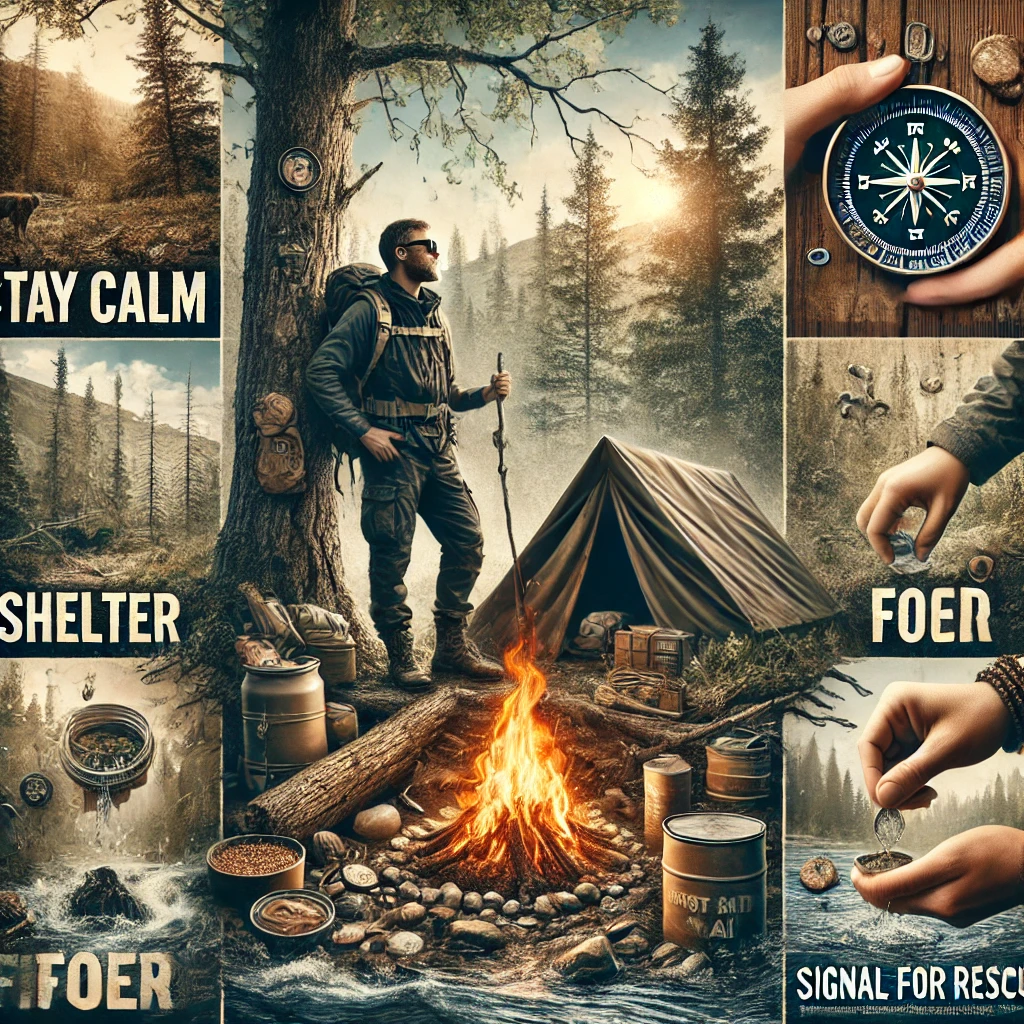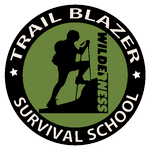
Imagine this: You’re miles away from civilization, surrounded by dense forest, and the sun is sinking below the horizon. The once vibrant sounds of the forest have quieted, leaving you alone with your thoughts and the growing chill in the air. In moments like these, your survival hinges not just on what you carry in your pack, but on the knowledge and skills from a reliable survival guide ingrained in your mind.
Whether you’re an experienced outdoorsman or someone who enjoys occasional hiking, this survival guide is your go-to resource for staying safe and sound when nature throws its worst at you.
1. Stay Calm: Your Mind is Your Greatest Weapon in Any Survival Guide
Panic is your enemy. When you realize you’re lost or facing a dangerous situation, the instinct to panic can be overwhelming. However, survival starts in the mind. Take a moment to stop, sit down, and breathe deeply. Clear your thoughts and focus on the task at hand. A calm mind will help you think clearly, conserve energy, and make decisions that could save your life. This is the foundation of any good survival guide.
Why It Matters
Staying calm helps you avoid rash decisions that could make your situation worse. Focusing on the present allows you to better assess your surroundings and resources. Every survival guide emphasizes the importance of maintaining a clear mind to navigate tough situations
Quick Tip
Practice mindfulness or breathing exercises in your everyday life. As our comprehensive survival guide highlights, these techniques can be lifesavers in a high-stress situation.
2. Shelter: Your First Priority in the Wild According to Any Survival Guide
Understanding the Importance of Shelter
Protection from the elements is crucial. In any survival situation, finding or creating a shelter should be your first physical action. Exposure to cold, rain, or wind can lead to hypothermia, even in temperatures that seem mild. Therefore, a good survival guide will teach you how to quickly find or build a shelter.
Types of Natural Shelters
Look for overhangs, caves, or thick bushes that can provide immediate protection. These can be lifesavers when you’re caught in a sudden downpour or cold snap. Moreover, a survival guide often includes tips on identifying natural shelters.
Building Your Own Shelter
If nature doesn’t provide, you’ll need to construct your own. A simple lean-to made from branches, leaves, and an emergency blanket can shield you from the elements. Additionally, remember to insulate the ground beneath you with leaves or pine needles to avoid losing body heat to the cold earth.
Quick Tip
Always carry a lightweight emergency shelter or tarp in your pack. It could be the difference between a cold, sleepless night and a warm, secure rest.
3. Fire: The Heartbeat of Survival in Any Guide
Why Fire is Essential
Fire is more than just warmth. It’s your means of cooking food, purifying water, signaling for help, and keeping predators at bay. Thus, mastering the art of building and maintaining a fire is a fundamental survival skill covered in any survival guide.
Gathering Materials for Fire
Start small. Collect dry tinder like leaves, grass, or birch bark. Build your way up with small sticks, then larger branches. The key is to start small and gradually add larger pieces of wood as the fire grows stronger.
Starting the Fire
Use a fire starter, waterproof matches, or a flint and steel. If you’re relying on natural methods, practice before you need to use them. Remember, conditions in the wild are rarely ideal.
Maintaining the Flame
Once your fire is going, keep it manageable. A large fire can consume precious resources and may even become a hazard. Keep extra wood nearby and ensure the fire doesn’t spread.
Quick Tip
Learn to build a fire in various conditions—wet, windy, or with limited materials. The more versatile your fire-building skills, the better your chances of survival.
4. Water: Life’s Most Precious Resource in Your Survival Guide
Finding Water Sources
Without water, survival is short-lived. Your body can survive weeks without food, but only days without water. Thus, finding and purifying water is critical to your survival, and every survival guide will prioritize this.
How to Locate Water in the Wild
Nature offers clues. Animal tracks, lush vegetation, and even certain insects can lead you to water. Furthermore, rainwater, dew, and snow (if available) are often safe but should still be purified.
Purification Methods
Never assume water is safe just because it looks clean. Boiling is the most reliable method—bring the water to a rolling boil for at least one minute. If boiling isn’t an option, use water purification tablets or a portable filter.
Quick Tip
Always carry a portable water filter and purification tablets in your pack. They’re lightweight and can save you from potentially deadly waterborne illnesses.
5. Food: Fueling Your Body and Mind for Survival
The Role of Food in Survival
Food might not be your immediate concern, but it’s vital for long-term survival. While you can survive weeks without it, your energy and morale will suffer. Therefore, knowing how to find food in the wild can keep you strong and focused, which is often covered in a survival guide.
Foraging for Food
Familiarize yourself with edible plants, nuts, and berries in the area you’re exploring. Be cautious—many edible plants have poisonous look-alikes. When in doubt, don’t eat it.
Hunting and Fishing Techniques
Small game is often easier to catch and can provide the protein you need. Learn how to set snares or traps, and consider carrying basic fishing gear. Even a simple line and hook can make a big difference.
Insects as a Food Source
High in protein and usually safe to eat, insects can be a reliable food source. Cook them if possible to improve taste and safety.
Quick Tip
Pack high-energy, non-perishable foods like nuts, dried fruit, and jerky in your kit. They’re lightweight, pack a nutritional punch, and can tide you over until you find more substantial food sources.
6. Navigation: Finding Your Way to Safety with Survival Guide Techniques
The Importance of Navigation
If you’re lost, knowing how to navigate is crucial. Moving in the wrong direction can lead you deeper into danger. Instead, focus on orienting yourself and finding a path to safety. Our survival guide offers detailed instructions on natural navigation techniques.
Natural Navigation Skills
The sun, stars, and even the growth of moss on trees can give you clues. In the northern hemisphere, moss typically grows on the north side of trees.
Marking Your Path
As you move, leave markers like stacked rocks or broken branches. This can help you find your way back or guide rescuers to you.
Quick Tip
Carry a compass and learn how to use it. It’s a simple tool that can be a lifesaver when your sense of direction fails.
7. First Aid: Addressing Injuries in the Wild with a Survival Guide
Why Basic First Aid is Vital
Injuries in the wilderness can escalate quickly. A small cut can become infected, or a sprained ankle can immobilize you. Knowing basic first aid is essential to your survival. Every survival guide stresses the importance of being prepared with basic medical knowledge.
Treating Wounds
Clean cuts with clean water, apply antiseptic, and cover them with a bandage. Change dressings regularly to prevent infection.
Managing Sprains and Strains
Immobilize the affected area with a splint made from sticks and fabric. Rest the injury as much as possible.
Handling Hypothermia
If someone shows signs of hypothermia, warm them slowly. Remove wet clothing, wrap them in dry layers, and give them warm liquids if possible.
Quick Tip
Always pack a well-stocked first aid kit and learn how to use everything in it. Knowledge of basic first aid can prevent minor injuries from becoming major threats.
8. Signal for Rescue: Your Ticket Home Using a Survival Guide
Why Signaling for Rescue is Essential
Your primary goal in a survival situation is to be found. Knowing how to signal for help can dramatically increase your chances of rescue.
Using Signal Fires
Three fires arranged in a triangle is an international distress signal. During the day, use green vegetation to create smoke.
Mirrors and Reflective Objects
These can catch the attention of aircraft or distant search parties. A flash of light can travel miles.
Whistles and Noises
A whistle can be heard over long distances with minimal effort. Shouting should be a last resort as it can quickly drain your energy.
Quick Tip
Practice creating different types of signals before you need them. In a survival situation, preparation is key.
Survival Is About More Than Skills—It’s About Mindset
Survival is as much mental as it is physical. The skills outlined here are crucial, but your mindset is what will ultimately get you through. Stay calm, stay focused, and remind yourself that every challenge is an opportunity to survive and thrive.
At Trail Blazer Survival School, we’re dedicated to helping you become a more confident and capable outdoorsman. While we’ve shifted our focus from group classes to providing in-depth articles, reviews, and expert advice, our mission remains the same: to equip you with the knowledge you need to stay safe and thrive in the wilderness.
Take Action Today
Want more expert survival tips and advice? Join our Survival Tips Newsletter today and take your first step toward becoming a true survivor.vice? Join our Survival Tips Newsletter today and take your first step toward becoming a true survivor.
